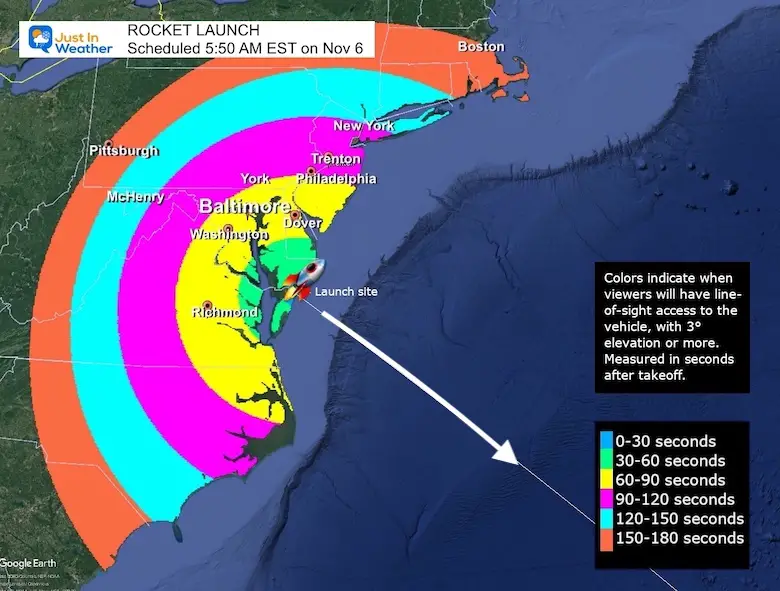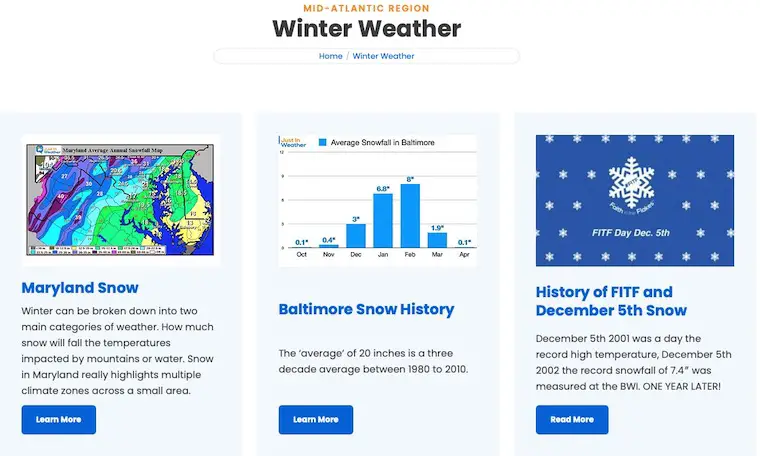Antares Rocket Photos Reaching Launchpad: Sunday Morning NASA Launch Mission Update
November 3 2022
The Antares Rocket has reached Virginia Space and Mid-Atlantic Regional Spaceport’s Pad 0A. These new photos are of the procedure from NASA and Brian Bonsteel. After being stood up for testing, it will be again lowered for final cargo loading.
Among the new scientific instrument will include bioprinting and the first satellites from Uganda and Zimbabwe. More on that mission and new video are below.
Close up of the Antares Rocket departing for the standup testing
A Northrop Grumman Antares rocket carrying a Cygnus spacecraft loaded with cargo bound for the International Space Station is transported horizontally to the Mid-Atlantic Regional Spaceport’s Pad-0A, Wednesday, Nov. 2, 2022, at NASA’s Wallops Flight Facility in Virginia. Northrop Grumman’s 18th contracted cargo resupply mission with NASA to the International Space Station will deliver more than 8,000 pounds of science and research, crew supplies and vehicle hardware to the orbital laboratory and its crew.
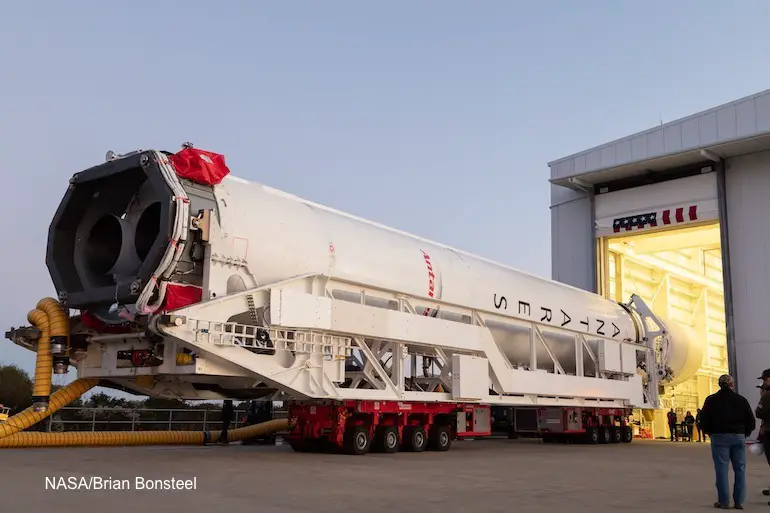
Wider view
Transport of the Antares Rocket on this special trailer.

The next supply mission to the International Space Station is scheduled for this weekend from Wallops Island, VA. This is a double win for the Mid Atlantic region of the US. It will be after the end of Daylight Saving Time as we turn the clocks back to Standard Time and get an extra hour of sleep. So, more may engage with the 5:50 AM launch time on Sunday.
This is the 18th Northrop Grumman commercial resupply mission for NASA to the International Space Station.

The next Antares launch is scheduled for 5:50 a.m. EST, Sunday, Nov. 6, from the Mid-Atlantic Regional Spaceport’s Pad 0A on Wallops Island. Weather permitting, this may be visible across metro Baltimore, Washington, and even into southern Pennsylvania.
Click this image to see the launch viewing info.
Mission Details According to NASA:
Full details (below the video) on some of the scientific investigations traveling to the space station on this mission:
Bioprinting tissues
The BioFabrication Facility (BFF) successfully printed a partial human knee meniscus and a large volume of human heart cells during its first trip to space in 2019. Now the payload is returning to the microgravity laboratory with new capabilities to further human tissue printing research.
The 3D bioprinter tests whether microgravity enables the printing of tissue samples of higher quality than those printed on the ground. The long-term goal is to use 3D bioprinting technologies to help alleviate organ shortages for patients in need of transplants by printing replacement organs and tissues.
“The research being conducted with BFF has exciting implications for the future of human health,” said Redwire executive vice president of In-Space Manufacturing and Operations John Vellinger. “Besides providing a clear benefit to our lives on Earth, advancing this technology on the International Space Station now is a great way to prepare for work on the commercial space stations of the future, which could be outfitted with critical research technology such as BFF.”
Launching on a future mission, BFF-Meniscus-2 will use the upgraded facility to evaluate using BFF to 3D print knee cartilage tissue using bioinks and cells. Demonstration of further capabilities for tissue fabrication in space also supports continued and expanded commercial use of the space station for fabricating tissues and organs for transplant on the ground. BFF-Meniscus-2 is sponsored by the ISS National Lab.
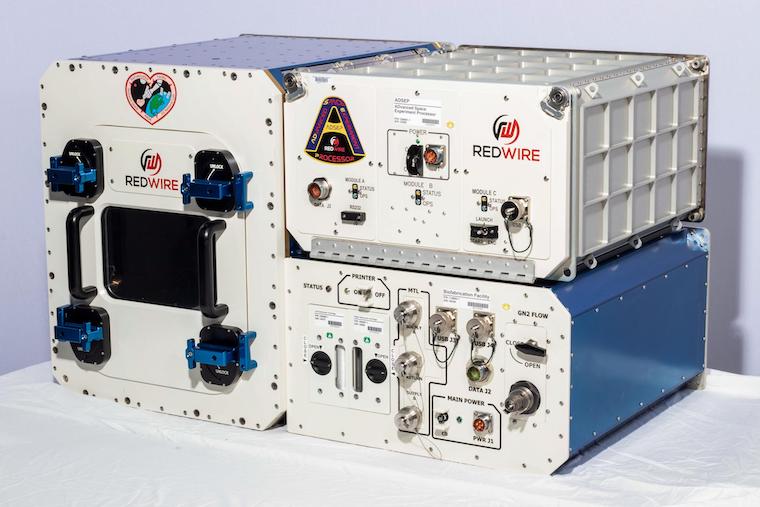
Assessing how plants adapt to space
Plants exposed to spaceflight undergo changes that involve the addition of extra information to their DNA, which regulates how genes turn on or off but does not change the sequence of the DNA itself. This process is known as epigenetic change. Plant Habitat-03 assesses whether such adaptations in one generation of plants grown in space can transfer to the next generation.
The long-term goal of the investigation is to understand how epigenetics can contribute to adaptive strategies plants use in space and, ultimately, to develop plants better suited for use on future missions to provide food and other services. Results also could support the development of strategies for adapting crops and other economically important plants for growth in marginal and reclaimed habitats on Earth.
In earlier experiments, researchers noticed that many genes associated with epigenetic modifications in plants were expressed differently in space. In additional studies, researchers caused plants to be deficient in key genes associated with specific epigenetic change. These plants were more affected by spaceflight than their wild-type (naturally occurring) counterparts and ground controls.
“This suggests that these changes play an important role in the physiological adaptation of plants to the spaceflight environment,” says principal investigator Anna-Lisa Paul, a professor at University of Florida. “The next question, and the subject of this experiment, is whether these spaceflight-induced epigenetic changes are carried to the next generation of plants and could confer an adaptive advantage for that environment.”
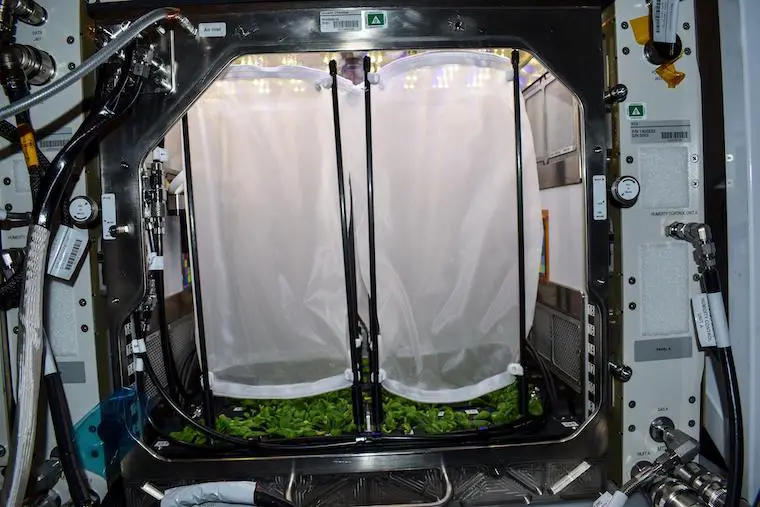
Mudflow mixtures
Climate change and global warming are contributing to increasing occurrence of wildfires. When a wildfire burns plants, combusted chemicals create a thin layer of soil that repels rainwater. Rain then erodes the soil and can turn into catastrophic mudflows that carry heavy boulders and debris downhill, causing significant damage to infrastructure, watersheds, and human life. Post-Wildfire Mudflow Micro-Structure (TangoLab Mission-28), sponsored by the ISS National Lab, evaluates the composition of these mudflows, which include sand, water, and trapped air.
“Gravity plays a crucial role in the process by driving air up and out of the mixture and particles down to the bottom of the water,” says Ingrid Tomac, an assistant professor in the University of California San Diego’s Structural Engineering Department. “Removing gravity, therefore, could provide insights into the internal structure dynamics of these sand-water-air mixtures and a baseline for their behavior. “
Results could improve understanding of the fundamental mechanisms that govern post-wildfire debris movement, including how mudflows trap air bubbles and can carry heavy boulders. This investigation also could help develop and validate fundamental equations to model and predict the spread and velocity of debris flows and their effect on houses, infrastructure, and natural obstacles.
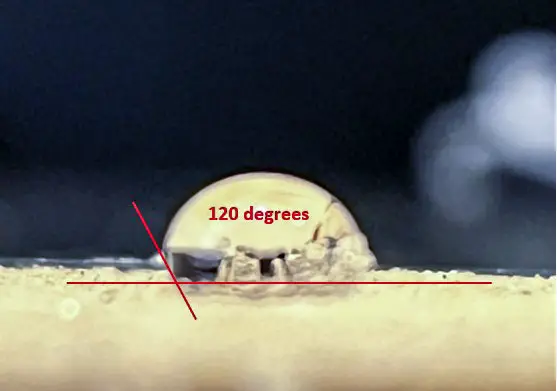
Ovarian cell development in microgravity
Sponsored by NASA and the Italian Space Agency (ASI) and coordinated by ASI, OVOSPACE examines the effect of microgravity on bovine cell cultures, research that could improve fertility treatments on Earth and help prepare for future human settlement in space.
Principal investigator Mariano Bizzarri, with the Department of Experimental Medicine, Sapienza University of Rome, explains that living for prolonged times in the reduced gravity of the Moon or Mars could impair fertility.
“This threatens the goal of establishing permanent or extended settlements beyond Earth,” Bizzari says. “Deregulation of the reproductive functions also may pose additional health risks. Our results could improve understanding of egg development and identify targets for countermeasures and treatments to protect reproductive potential on space missions. This investigation also could support development of treatments to improve or restore fertility in people on Earth.”
First satellites from Uganda and Zimbabwe
BIRDS-5 is a constellation of CubeSats: PEARLAFRICASAT-1, the first satellite developed by Uganda; ZIMSAT-1, Zimbabwe’s first satellite; and TAKA from Japan. BIRDS-5 performs multispectral observations of Earth using a commercial off-the-shelf camera and demonstrates a high-energy electronic measuring instrument. The statistical data collected could help distinguish bare ground from forest and farmland and possibly indicate the quality of agricultural growth. This could help improve the livelihood of citizens of Uganda and Zimbabwe.
A cross-border university project, BIRDS provides students from developing nations with hands-on satellite development, laying a foundation for similar space technology projects in their home countries that ultimately could lead to sustainable space programs there.
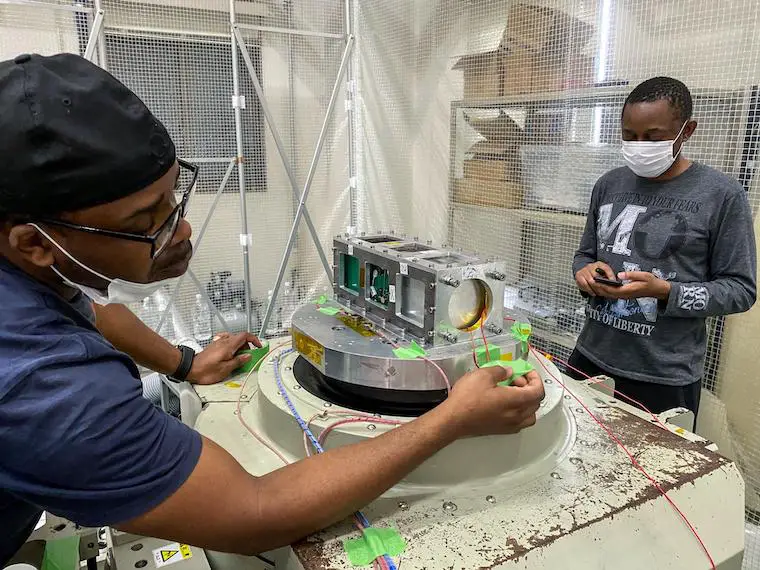
NASA TV Coverage
Sunday, November 6:
- 5:30 a.m. – Launch coverage begins
- 5:50 a.m. – Launch window opens
Tuesday, November 8:
- 4:30 a.m. – Rendezvous coverage begins
- 5:50 a.m. – Capture of Cygnus with the space station’s robotic arm
- 7:30 a.m. – Cygnus installation operations coverage
Winter Weather Folklore Top 20 And More Outlook Signals From Nature For Cold And Snow
Weather posts straight to your inbox
Sign up and be the first to know!
Also See: Winter Outlook Series:
ALSO SEE THESE OTHER WINTER OUTLOOK REPORTS
Farmer’s Almanac Comparison
September Starts Meteorological Autumn: Weather Climate Stats For Maryland at Baltimore
Triple Dip La Niña Winter
CONNECTION TO WINTER?
If you want a snowy winter, this is what you might want to look for in the rest of the tropical season. (You might be seeing a lot of commercial snow removal people out this Winter).
Rainbow Ice Cave In Mt. Rainier A Very Rare Find: Photos And Video
Wooly Bear Caterpillars
https://justinweather.com/2022/10/25/winter-weather-outlook-from-the-wooly-bear-caterpillar/
Persimmon Seeds
Click to see Top 20 and MORE
Winter Weather Folklore Top 20 And More Outlook Signals From Nature For Cold And Snow
Normals And Records: Maryland and Baltimore Climate History
Faith in the Flakes Gear
SNOWSTIX – Available Now
Please share your thoughts, best weather pics/videos, or just keep in touch via social media
-
Facebook: Justin Berk, Meteorologist
-
Twitter: @JustinWeather
-
Instagram: justinweather




